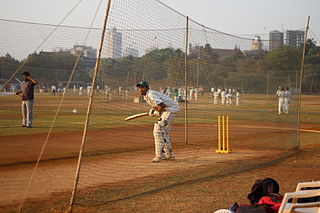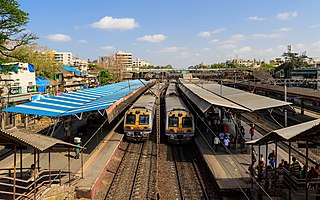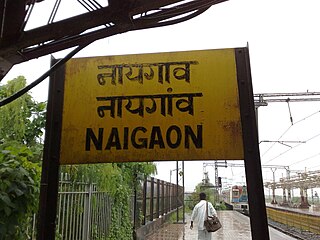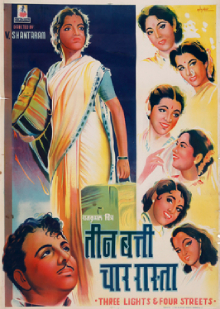Related Research Articles

The Gateway of India is an arch-monument completed in 1924 on the waterfront of Mumbai (Bombay), India. It was erected to commemorate the landing of George V for his coronation as the Emperor of India in December 1911 at Strand Road near Wellington Fountain. He was the first British monarch to visit India.

Matunga Road is the name of a railway station on the Western Line of the Mumbai Suburban Railway network. It offers access to Matunga and Shivaji Park areas of Mumbai. It should not be confused with the nearby Matunga railway station, which is on the Central Line just to the east. Matunga Road is one of the smallest railway halt in Mumbai in terms of number of passengers and number of platforms. The Ruparel College is the nearest college to this station. Fast local trains between Churchgate and Virar do not stop at Matunga Road station. It has been documented as the first suburban station on Western Railway to be run by all-women staff.

Mahalaxmi, also spelled Mahalakshmi, is a railway station on the Western Line of the Mumbai Suburban Railway in Mahalaxmi, Mumbai. Trains starting from Churchgate pass through Mahalaxmi. The next station south is Mumbai Central Station; the next station north is Lower Parel Station. Major landmarks in the area are the Mahalaxmi Temple, Haji Ali Dargah, Nehru Planetarium and Mahalaxmi Racecourse Dabbawalla Statue. Worli Seaface is also close from here. Byculla station of the Central Railway is the closest station.

Azad Maidan is a triangular-shaped maidan in the city of Mumbai, India. It is located on 25 acres (10 ha) of land near the Chhatrapati Shivaji Terminus station. It is a regular venue for inter-school cricket matches. The name Azad means "liberty" in Persian. The ground is known for its cricket pitches, for protest meetings, and for political rallies. The Bombay Gymkhana clubhouse was built in 1875, at the southern end of the maidan.

The Bombay, Baroda and Central India Railway was a company incorporated in 1855 to undertake the task of constructing railway lines between Bombay to the erstwhile Baroda State, that became the present-day Baroda (Vadodara) city in western India. BB&CI completed the work in 1864. The first suburban railway in India was started by BB&CI, operating between Virar and Bombay Backbay station, a railway station in Bombay Backbay in April 1867.

The Eros Cinema is an Art Deco style cinema theatre located in Cambata Building at Churchgate, Mumbai, India. It has a seating capacity of 1,204 people per show.

Vasai Road Junction is a railway station on the Western line and Vasai Road–Roha line of the Mumbai Suburban Railway network.
Sharada Dwivedi ,(c. 1942 – 6 February 2012) was an Indian author, historian and researcher. She wrote several books on the history and culture of both India and Mumbai. She was on the panel on the Mumbai Heritage Conservation Committee. Among her most famous work was Bombay, the Cities Within (1995). She had great fascination for Victorian-era Mumbai and later in her life, she developed a great affection for the city's art deco stylings.
Charles Boone, of Rook's Nest, in Tandridge, and Godstone, Surrey, was an East India Company officer and politician who sat in the House of Commons from 1727 and 1734. He was a British governor of the Bombay Presidency from 1715 to 1722.

Ballar Bunder Gatehouse is a Grade I Heritage structure that has been converted into a maritime museum, located at Ballard Estate in the old Fort area of Mumbai, India. It was built in 1920 to commemorate the realignment of the harbour and is located where Ballard Pier, a small pier once existed with an approach jetty at right angles to the pier. The building was among the five entries from the Mumbai for the 2009 UNESCO Asia-Pacific Heritage Awards for Culture Heritage Conservation. It is one of the stops on Special tour of Museums in the city, a tour organised by BEST and MTDC as well as the Naval Dockyard Heritage Walk, conducted by the Naval Dockyard on the first Sunday of every month.

Churchgate is the southern terminus on the Western Line of the Mumbai Suburban Railway. It is located in Churchgate in South Mumbai, Maharashtra.

Mahim Junction is a railway station on the Western line and Harbour Line of the Mumbai Suburban Railway network. It serves the last town of the Mumbai city : Mahim.

Vile Parle is a railway station on the Western line and Harbour line of the Mumbai Suburban Railway network. It serves the Vile Parle locality.

Bhayandar is a railway station on the Western line of the Mumbai Suburban Railway network.

Naigaon is a railway station on the Western Line of the Mumbai Suburban Railway Network.

Teen Batti Char Raasta is a 1953 Hindi-language comedy drama film on national integration directed by V. Shantaram. The film was made under the Rajkamal Kalamandir banner and produced by Shantaram. The story and dialogue were by Diwan Sharar while the cinematography was by G. Balkrishna. With music composed by Shivram Krishna, it had lyrics by Pyare Lal Santoshi. The star cast included Karan Dewan, Sandhya, Shashikala, Nirupa Roy, Sheila Ramani, Dewan Sharar and Lalita Kumari.
India: the Urban Transition is a book by the Danish architect-urbanist Henrik Valeur, curator of an award winning exhibition about the urban transition of China. The book is based on the author's collaboration with activists, bureaucrats, developers, entrepreneurs, researchers and students in India between 2010 and 2014. With experiences from both China and India, Henrik Valeur asks whether India can “use urbanization as a driver of economic, human and social development like China has done?”

The Art Deco in Mumbai, India style is a notable feature of the architecture of the city. It was used primarily for office buildings, residences and movie theaters, during a period when India was part of the British Empire. On 30 June 2018, an ensemble of such buildings were officially recognized as a World Heritage site by the UNESCO World Heritage committee held in Bahrain as the Victorian and Art Deco Ensemble of Mumbai.

Sir Temulji Bhicaji Nariman RCSEd, also recorded as Tehmulji B. Nariman, was a obstetrician from Bombay who co-founded one of the city's first lying-in hospitals in 1887 and was knighted in 1914 for his work during the plague epidemic in India at the turn of the 19th century.

The Parsi Lying-in Hospital (PLIH), also known as Temulji's Lying-in Hospital, sometimes spelled Tehmulji's Lying-in Hospital, was one of the first maternity hospitals in Bombay. It was co-founded by physician and obstetrician Temulji Bhicaji Nariman in 1887 and completed in 1895. Dwindling numbers of Parsi births in the latter half of the 20th century led to its closure.
References
- ↑ "Rahul Mehrotra to head Harvard School of Design". Sify . Archived from the original on 19 October 2012. Retrieved 9 August 2022.
- ↑ Shah, Ranvir (5 July 2009). "Celebrating heritage". The Hindu. Retrieved 8 October 2018.
- ↑ "Home". udri.org.
- ↑ "Urban Landscape gets New Corner-Room Architects". The Times Of India. 13 August 2012. Archived from the original on 7 November 2017.
- ↑ "IIHS receives a Rs 50 cr gift from Nandan, Rohini Nilekani". Business Standard. 20 January 2013.
- ↑ "Architect Rahul Mehrotra balances teaching at Harvard and practice in India | Harvard Magazine". 25 April 2012.
- ↑ "Housing for Mahouts and their Elephants / RMA Architects". ArchDaily. 6 June 2013. Retrieved 26 March 2023.
- ↑ Khatri, Aastha (9 May 2021). "KMC Corporate Office by Rahul Mehrotra: Modulation of light and air". RTF | Rethinking The Future. Retrieved 28 March 2023.
- ↑ "CSMVS - Visitor Centre at the Prince of Wales Museum / RMA Architects". ArchDaily. 18 April 2013. Retrieved 28 March 2023.
- ↑ "House in a Tea Garden / RMA Architects". ArchDaily. 2 May 2013. Retrieved 28 March 2023.
- ↑ "HP Campus RMA Architects". indian-architects. 2006. Retrieved 28 March 2023.
- ↑ "Restoration of the Chowmahalla Palace Complex". world-architects.com. 2007. Retrieved 29 March 2023.
- ↑ "A "Magic Bus" For City Kids". www.magicbus.org. Retrieved 29 March 2023.
- ↑ "Prince of Wales Visitors Centre by RMA Architects". Dezeen. 26 October 2011. Retrieved 1 April 2023.
- ↑ "Om Books International". www.ombooksinternational.com. Retrieved 1 April 2023.
- ↑ "Rahul Mehrotra's 'Architecture in India Since 1990'". Asia Society. Retrieved 1 April 2023.
- ↑ Mathew, Bhakti Bapat (29 March 2013). "Mumbai's art deco heritage a nod to a history of style". The National. Retrieved 1 April 2023.
- ↑ "Banganga: Sacred Tank on Malabar Hill | Eminence Publishing" . Retrieved 1 April 2023.
- ↑ Mehrotra, Rahul (2006). A City Icon: Victoria Terminus Bombay, 1887 Now Chhatrapati Shivaji Terminus Mumbai, 1996. Eminence Designs. ISBN 978-81-903821-0-6.
- ↑ "Everyday Urbanism | Taubman College of Architecture & Urban Planning". taubmancollege.umich.edu. Retrieved 1 April 2023.
- ↑ UDRI. "CONSERVATION AFTER LEGISLATION". URBAN DESIGN RESEARCH INSTITUTE. Retrieved 1 April 2023.
- ↑ "The Bombay High Court ; The Story of the Building, 1878-2003 - Mehrotra, Rahul, Dwivedi, Sharada: 9788190060257 - AbeBooks". www.abebooks.com. Retrieved 1 April 2023.
- ↑ "World Architecture . A critical mosaic 1900 - 2000 . Volume 8 / VIII. South Asia, General editor : Kenneth Frampton . Volume editor : Rahul Mehrotra , by Frampton , K. / Mehrotra, R. (Edit.) | Johann Peter Hebel Antiquariat". www.abebooks.com. Retrieved 1 April 2023.
- ↑ "Anchoring a City Line 1899-1999. The history of the western suburban railway and its headquarters in Bombay | Eminence Publishing" . Retrieved 1 April 2023.
- ↑ "Fort Walks | Eminence Publishing" . Retrieved 1 April 2023.
- ↑ www.bibliopolis.com. "Bombay to Mumbai: Changing Perspectives by Pratapaditya Pal, general on Mullen Books". Mullen Books. Retrieved 1 April 2023.
- ↑ "Banganga: Sacred Tank on Malabar Hill | Eminence Publishing" . Retrieved 1 April 2023.
- ↑ "Bombay The Cities Within | Eminence Publishing" . Retrieved 1 April 2023.
- ↑ UDRI. "The Fort Precinct in Bombay: Conserving an Image Centre – Vol I". URBAN DESIGN RESEARCH INSTITUTE. Retrieved 1 April 2023.
- ↑ "The State of Architecture: Practices and Processes in India". World Architecture Community. Retrieved 1 April 2023.